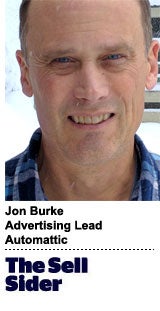 “The Sell Sider” is a column written by the sell side of the digital media community.
“The Sell Sider” is a column written by the sell side of the digital media community.
Today’s column is by Jon Burke, advertising lead at Automattic.
Snapchat is the latest major publisher to go public with its brand safety partnerships. Prior to that, Facebook revealed that it would hire 3,000 new workers to focus on user and brand safety. Google announced that it would partner with comScore on brand safety after being called out over brand safety mishaps.
Given that these are three of the biggest players in online advertising, observers might conclude that the issue is being fixed.
Unfortunately, the online advertising industry has a remarkable penchant for not addressing persistent issues. These announcements are certainly not going to stave off brand safety outrages.
Brand safety doesn’t work because there are no standards and because advertisers are made promises that can’t be met. There are any number of brand safety tools, including Integral Ad Science, Moat, Grapeshot, zvelo and comScore, as well as in-house solutions that Google and others have developed. With these brand safety tools, companies get paid at least twice – once by the publisher and again by the buyer. They are currently not incentivized to create order and standards.
There are a great deal of false positives and false negatives from these services. For example, one major vendor incorrectly categorizes millions of unique WordPress sites as the same site.
Many publishers maintain their own whitelists of brand-safe sites, and then each of their dozens of buying partners has their own whitelist. Brand safety standards differ from buyer to buyer. Managing dozens of whitelists is chaotic and error-prone.
With the rash of brand safety announcements, buyers’ standards quickly changed. A site that is blacklisted by Google and Facebook, for example, may have been cleared earlier. But one can still easily find ads running on content that is clearly not brand-safe.
The industry seems to give buyers the false impression that they can be brand-safe 100% of the time. That’s not possible. Most advertising is running on user-generated content on Facebook, Snapchat and other platforms. It’s simply not possible for brand safety auditors to view all that content and approve it. So, we should expect to see more scandals where advertisers are called out for running alongside dirty content.
Another question that arises is that different countries have different views on brand safety. We mostly see the US view applied.
Imagine a world where buyers could opt into a standard where they are sure that 95% of impressions would be brand-safe. For example, standard-setters could agree that some curse words and images of people in swimsuits are acceptable, but hate speech and nudity are not. There is a gray area, and the standard-setters could define that as best they can.
With this universal standard, buyers could then assure their advertisers that they will only run on content that falls within this universal standard, but they should be aware that there’s a 5% chance they might appear on content that is disagreeable. Publishers could work with the brand safety tool-providers to certify that they meet this standard. Brand safety tool-providers could be certified, to ensure that they’re capable of managing to that standard.
If Google, Facebook, Amazon, Criteo and others could get together and agree on a joint standard for brand safety, other buyers and platforms would surely jump on board. Publishers would know what the standard is and would work toward it or lose advertising revenue. There are many other standards in online advertising, from ad sizes to RTB specifications. Why not brand safety, too?
The Trustworthy Accountability Group (TAG) and JICWEBS in the UK are focused on this goal and could be the answer. Procter & Gamble announced that it is requiring “any entity touching digital media” it buys to get accredited during 2017 by TAG. This could be the catalyst to making a brand safety standard a reality.
Follow Automattic (@automattic) and AdExchanger (@adexchanger) on Twitter.











